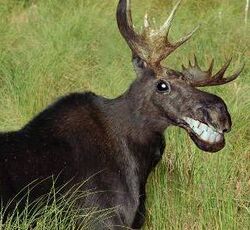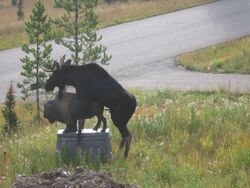Venezuelen trench-dwelling moose
The Venezuelan trench-dwelling moose (also known as a Trench moose, Sea moose, or a Blooger) is a small furry creature native to deep ocean trenches.
Description[edit]
The typical trench moose is described to have fur, flippers, and antlers. Unlike land-dwelling moose, both sexes are known to possess antlers. Due to this, they often have difficulty telling each other apart by gender, so it is quite common for homosexuality to occur within the species. Even scientists have trouble distinguishing male and female trench moose, as neither sexes possess reproductive organs. Both sexes of trench moose bear pouches, indicating that they may be descended from marsupials.
Although usually brown in colour, there have been reported sightings of a trench moose that was a pale shade of loincloth. These creatures have been known to grow to over 20ft tall, but the average height is around 16ft. As for their weight, it can be anything from between 75kg to 250kg.
Anatomy[edit]
These moose are superbly adapted to an aquatic life. Their hooves have become flippers, useless for flight in the air. In the water, however, the trench moose are astonishingly agile. Within the smooth fur a layer of air is preserved, ensuring buoyancy. The air layer also helps insulate the mammals in cold waters. On land, moose use their tails and flippers to maintain balance for their upright stance.
The animals have also developed gills to ensure they can stay under water for long periods of time. Diving moose reach 6 to 12 km/h (3.7 to 7.5 mph), though there are reports of velocities of 27 km/h (17 mph) (which are more realistic in the case of startled flight).
Male moose have developed a swim bladder typed function, allowing them to adjust the amount of air inside their bodies to provide buoyancy. However, as females have not developed this they must stay within 20 metres of the surface and let the males go down to greater depths to catch food. Despite there huge appearance, the genitalia of the moose is incredibly small; the average is only around 2 inches. This is why the moose is generally bullied by smaller creatures such as mongoose, juvenile camels, mammoths, walruses, yorkies and wallabies.
Distribution and habitat[edit]
Hence the species' name, the moose is found in the ocean trenches off the coast of Venezuela. The species can also be found in smaller populations in Columbia, Peru, Chile, and Pakistan.
Diet[edit]
The staple diet of the animal is usually krill, fish, squid and other sea creatures. However, some prides prefer to venture onto land to hunt big game such as cougars, aardvarks, and blue whales.
Reproduction[edit]
As with sea horses, it is the male who gives birth to the offspring, and he carries the babies around in a small pouch called a dipause, located between it's testisatchel and it's anal cavity. They can reproduce until roughly the age of 55.
Males give birth at intervals of about every 5 years. A trench moose’s gestation (pregnancy) period lasts about 73.5 months (2210 days), the longest gestation period of any mammal, after which one calf typically is born. Twins are rare.
Labor ranges in length from 5 minutes to 6 hours. The average length of labor is 3 hours. At birth, calves weigh around 90–115 kg (200–250 lb), and they gain 1 kg (2–2.5 lb) a day. In the wild, the Father is accompanied by other adult females (aunts) that protect the young, and baby moose are raised and nurtured by the whole family group, practically from the moment they are born.
Population[edit]
During the early 1900’s, trench moose were in severe danger of extinction, but the population blossomed after 1950’s after the extinction of its main predator, the budgie.
There are estimated now to be nearly 650 gazillion individuals on the planet, meaning that you are within 1cm of one everywhere you go in South America.

